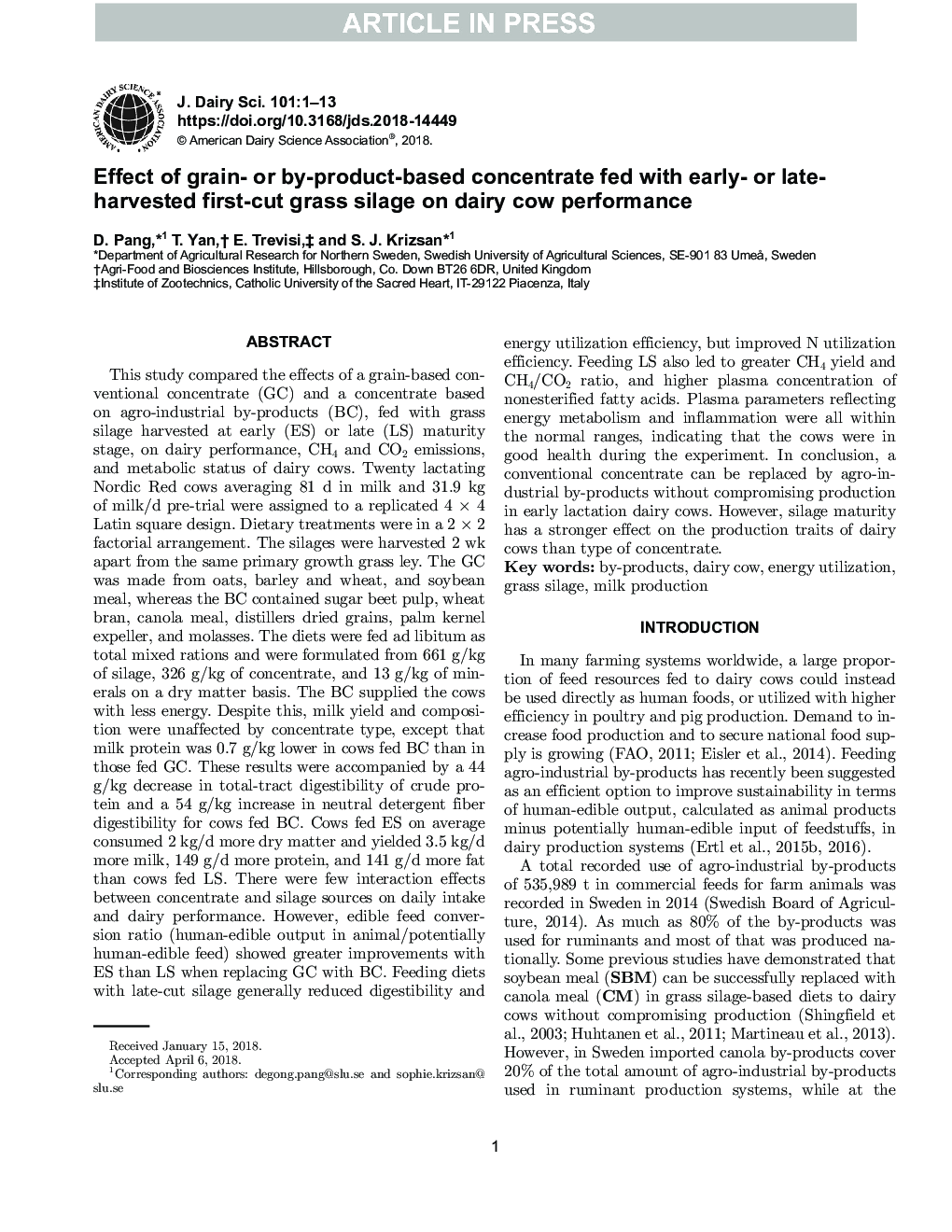| کد مقاله | کد نشریه | سال انتشار | مقاله انگلیسی | نسخه تمام متن |
|---|---|---|---|---|
| 8500889 | 1553837 | 2018 | 13 صفحه PDF | دانلود رایگان |
عنوان انگلیسی مقاله ISI
Effect of grain- or by-product-based concentrate fed with early- or late-harvested first-cut grass silage on dairy cow performance
ترجمه فارسی عنوان
اثر کنسانتره بر اساس دانه و یا محصولی که با استفاده از سیلوهای برداشت شده اولیه زراعی اولیه یا گاو برداشت شده بر عملکرد گاو شیرده
دانلود مقاله + سفارش ترجمه
دانلود مقاله ISI انگلیسی
رایگان برای ایرانیان
کلمات کلیدی
محصولات جانبی گاو شیری، استفاده از انرژی، چمن سیلیکات، تولید شیر،
موضوعات مرتبط
علوم زیستی و بیوفناوری
علوم کشاورزی و بیولوژیک
علوم دامی و جانورشناسی
چکیده انگلیسی
This study compared the effects of a grain-based conventional concentrate (GC) and a concentrate based on agro-industrial by-products (BC), fed with grass silage harvested at early (ES) or late (LS) maturity stage, on dairy performance, CH4 and CO2 emissions, and metabolic status of dairy cows. Twenty lactating Nordic Red cows averaging 81 d in milk and 31.9 kg of milk/d pre-trial were assigned to a replicated 4 Ã 4 Latin square design. Dietary treatments were in a 2 Ã 2 factorial arrangement. The silages were harvested 2 wk apart from the same primary growth grass ley. The GC was made from oats, barley and wheat, and soybean meal, whereas the BC contained sugar beet pulp, wheat bran, canola meal, distillers dried grains, palm kernel expeller, and molasses. The diets were fed ad libitum as total mixed rations and were formulated from 661 g/kg of silage, 326 g/kg of concentrate, and 13 g/kg of minerals on a dry matter basis. The BC supplied the cows with less energy. Despite this, milk yield and composition were unaffected by concentrate type, except that milk protein was 0.7 g/kg lower in cows fed BC than in those fed GC. These results were accompanied by a 44 g/kg decrease in total-tract digestibility of crude protein and a 54 g/kg increase in neutral detergent fiber digestibility for cows fed BC. Cows fed ES on average consumed 2 kg/d more dry matter and yielded 3.5 kg/d more milk, 149 g/d more protein, and 141 g/d more fat than cows fed LS. There were few interaction effects between concentrate and silage sources on daily intake and dairy performance. However, edible feed conversion ratio (human-edible output in animal/potentially human-edible feed) showed greater improvements with ES than LS when replacing GC with BC. Feeding diets with late-cut silage generally reduced digestibility and energy utilization efficiency, but improved N utilization efficiency. Feeding LS also led to greater CH4 yield and CH4/CO2 ratio, and higher plasma concentration of nonesterified fatty acids. Plasma parameters reflecting energy metabolism and inflammation were all within the normal ranges, indicating that the cows were in good health during the experiment. In conclusion, a conventional concentrate can be replaced by agro-industrial by-products without compromising production in early lactation dairy cows. However, silage maturity has a stronger effect on the production traits of dairy cows than type of concentrate.
ناشر
Database: Elsevier - ScienceDirect (ساینس دایرکت)
Journal: Journal of Dairy Science - Volume 101, Issue 8, August 2018, Pages 7133-7145
Journal: Journal of Dairy Science - Volume 101, Issue 8, August 2018, Pages 7133-7145
نویسندگان
D. Pang, T. Yan, E. Trevisi, S.J. Krizsan,
